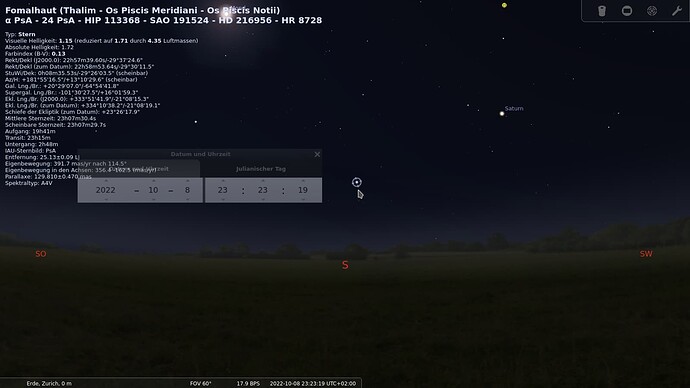Have you ever needed to know where the moon was during the Battle of Hastings? Probably not, but there is a marvellous piece of software which goes by the unassuming name of aa which can compute the position in the sky of any planet, sun, moon, or star, in any year/date, and at any time.
As an example we are going to use aa to find where the Moon was during the Battle of Hastings. Hastings is at latitude 50.85 degrees and Longitude 0.5734 degrees. The Battle was on 14 Oct 1066, starting at 9.00 am. We will need these data to setup aa for that location.
aa is available in Debian as the package astronomical-almanac so it installs with
apt-get install astronomical-almanac
You will get a binary in /usr/bin, files in /usr/share/doc/astronomical-almanac, and more files in /usr/share/aa,
and a global init file in /etc/aa.ini. That is all. It is a C program.
To run aa you need an aa.ini file defining the location ( on earths surface) of interest. Here is my aa.ini file for Hastings in the UK
0.5734 ;Terrestrial east longitude of observer, degrees
50.85 ;Geodetic latitude, degrees
20.0 ;Height above sea level, meters
15.0 ;Atmospheric temperature, deg C
1010.0 ;Atmospheric pressure, millibars
1 ; 0 - TDT=UT, 1 - input=TDT, 2 - input=UT
0.0 ;Use this deltaT (sec) if nonzero, else compute it.
Put this in a clean directory, then
cd cleandirectory
aa
Then the fun begins. aa is one of those old fashioned so called interactive programs… the sort of thing you might have used in the 1970’s sitting at a teletype on a minicomputer . It asks questions. Here are the questions
Steve Moshier's Ephemeris Program v5.6
Planetary and lunar positions approximate DE404.
Terrestrial east longitude 0.5734 deg
geocentric latitude 50.6614 deg
Earth radius 0.99799
temperature 15.0 C
pressure 1010 mb
Input time is TDT.
Enter starting date of tabulation
Calendar date: Year (1986) ? 1066
Month (1-12) (1) ? 10
Day.fraction (1.000000) ? 14
Julian Calendar assumed.
Time: Hours (0) ? 9
Minutes (0) ?
Seconds (0.000000) ?
1066 October 14 Saturday 8h 39m 10.734s UT
1066 October 14 Saturday 9h 00m 00.000s TDT
Julian day 2110700.8750000
Enter interval between tabulations in days (1.000000) ?
Number of tabulations to display (1) ?
Planet number 0-9 or 88 to read star, 99 to read orbit (0) ? 3
So it has read the aa.ini file and you can see its content listed, then
I have to enter
1066 for year
10 for month
14 for day
9 for hour
and I set it to 1 days result at 1 day intervals
and choose planet no 3 (which happens to be the moon)
then it lists the result
The Moon
JD 2110700.88, 1066 October 14 Saturday 8h 39m 10.734s UT
1066 October 14 Saturday 9h 00m 00.000s TDT
nutation dRA -0.280s dDec -7.27"
Geometric lon 117.605 deg, lat -4.425 deg, rad 2.6882e-03 au
Apparent geocentric longitude 117.604 deg latitude -4.425 deg
Distance 63.052 Earth-radii
Horizontal parallax 0d 54' 31.49" Semidiameter 0d 14' 51.37"
Elongation from sun 89.10 deg, Illuminated fraction 0.49
Phase 0.08 days past Third Quarter
Apparent: R.A. 7h 55m 09.153s Declination 16d 24' 14.13"
Local apparent sidereal time 10h 34m 56.152s
diurnal aberration dRA 0.011s dDec 0.04"
diurnal parallax dRA -93.090s dDec -1996.98"
atmospheric refraction 0.017 deg dRA 2.395s dDec 51.97"
Topocentric: Altitude 42.454 deg, Azimuth 237.527 deg
Topocentric: R.A. 7h 53m 38.469s Dec. 15d 51' 49.16"
local meridian transit 1066 October 14 Saturday 5h 54m 11.760s UT
rises 1066 October 13 Friday 22h 11m 29.851s UT
sets 1066 October 14 Saturday 13h 30m 36.428s UT
Visible hours 15.3185
Marvellous. The moon rose at 22h 11m the previous day, and set at 13h 30m on the day of the battle. It was .08 days past third quarter.
So the moon was in the sky during the day of the battle, and it set in the early afternoon. The battle ended at sunset, and there was no moon then, so they had to bury the dead next day.
Now , that is OK for a single result. What I want to do with aa is calculate Moon information for a whole series of successive days over a period of 20 years. It will do it, but that arcane output generates one of those result sheets for each day. I am going to have to write a C program or a script to extract the data I need.
And, aa’s documentation is poor. It reads like a scientific treatise on celestial computations, and forgets to show the user how to use the program For example … how did I know the Moon was planet no 3? Not from the docs… I had to read the source code to find out.
There is an online version. Not sure it is exactly the same as aa
and there are a number of programs , including source for aa here
http://www.moshier.net/
Have fun if you try aa.
Neville
